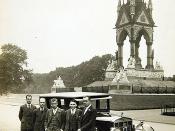The Wendigo appears in two quite different realms in Pet Sematary. Louis first meets it in the dream land beyond the deadfall, where its forms are somewhat vague and mythical. He later meets it in the ordinary world, where it inhabits the body of his dead two-year-old son, Gage. The dream land occurs in a physical setting as well as in Louis's dreams. It is the realm of the Indian Woods, where the Micmac Burial Ground is. King sets up this wilderness carefully. It is said to be haunted, to evade ownership, to be a place where one can easily get lost, to have vague, perhaps non-existent boundaries. Pascow tells Louis to remain on the pastoral side, where the scenery is beautiful, family is unified, and even children learn to accept death as final (87). When Louis sees the Wendigo in the wilderness and again later in a nightmare, it is a grotesque, laughing god, a face with up-tilted, yellowish-gray, gleaming eyes, mouth drawn down in a rictus, lower lip turned out, blackish-brown, worn down teeth, ram's horns for ears, black pulsing veins in the lips, flared nostrils expelling white vapors, a long, pointed, dirty-yellow, scaled and peeling tongue, with a white worm underneath it (362, 390).
This realm, then, is a physically existing dream land, like Goodman Brown's forest, where the dark man waits to welcome erring humans into his fellowship. And like Hawthorne's forest, the Indian Woods exists at two levels, as an actual place and as the realm of nightmares, where humanity's darker fears take physical form and from which they threaten to escape if encouraged.
Within the world of the novel, the Wendigo is physically confined to the wilderness unless someone buries a dead being, especially a human being, at the Micmac Burial Ground. Then, the...
![[Portrait of Louis Armstrong and Jack Teagarden, between 1938 and 1948] (LOC)](https://s.writework.com/uploads/4/45429/portrait-louis-armstrong-and-jack-teagarden-between-1938-an-thumb.jpg)
![[Slim Sallee & Jack Bliss?, St. Louis NL (baseball)] (LOC)](https://s.writework.com/uploads/3/39861/slim-sallee-jack-bliss-st-louis-nl-baseball-loc-thumb.jpg)

Well Written
This paper was very good. The author shows they know a lot of information about Stephen King and his novels. The author was able to express what they wanted to say very clearly and fluently. I can not think of any criticisms to say. Nice job!
4 out of 4 people found this comment useful.